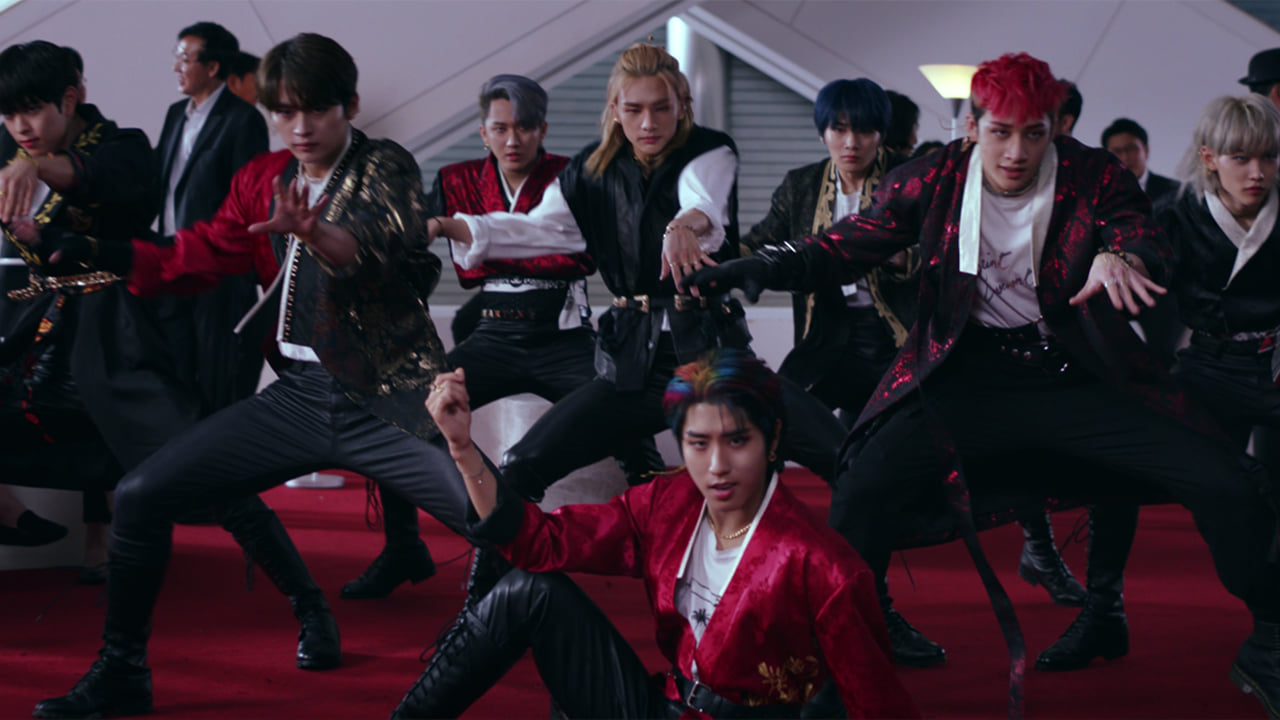
Following up the summer success of “God’s Menu” and its accompanying album, Go Live, Stray Kids are back with a repackaged version, In Life, along with a new single, “Back Door”. Through sharpened songwriting, concept ideas and MV execution, the former deservedly went on to become their most successful MV and album yet, in terms of views and sales.
Luckily for the group, what “God’s Menu” began, “Back Door” has only accelerated, and to a scarily fast pace that marks them out as ones to watch in the current generation. After experimentation in their rookie years, Stray Kids have worked out what works, trimmed the remaining fat and refined their recipe to perfection, creating a song and MV that is sleek, lean and dynamic, and which suits them down to the ground – while also expressing growth and maturation.
Never one to shy away from unconventional titles, Stray Kids use “Back Door” to hint at a kind of VIP party that you can only get in to through a metaphorical back door. The lyrics invite the listener to join them in their secret gathering – in other words, it invites non-fans to become fans (in this case, literally to come through the “Back Door” i.e. listening to this song). Perhaps the clearest allusion to this is the opening line and verse, where they reference the success of “God’s Menu” while surrounded by characters from that MV, before hinting that even better things are to come:
Hey, you wanna come in?
Clean it all up, I’m going in now
That last one was just an appetizer
Now it’s time for the main party
If you can’t handle it, you can leave, yeah
While their previous songs and MVs were, like most boy groups, packed full of aural and visual details designed to stimulate the senses as much as possible, “Back Door” (and to a lesser extent “God’s Menu”) has adopted much more of a minimalistic approach, even while maintaining raucous hooks and energetic choreography.
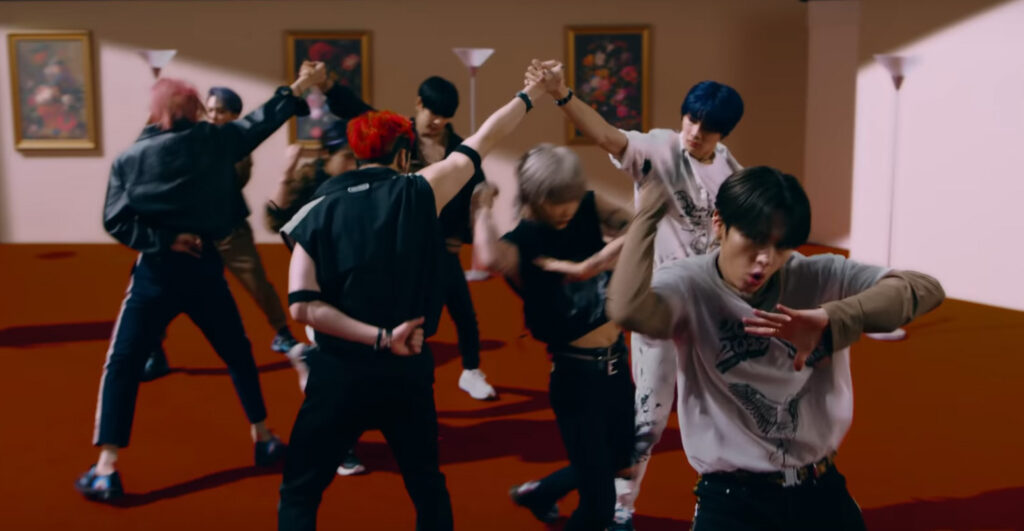
In terms of music, this manifests as a song of short length (3:10), with a more spacious soundscape than we’re used to hearing from them. No section is longer than necessary, nor is any sound or instrument used too loudly or for too long – each adds something of significant value so that there is no excess fat.
That doesn’t mean the song sounds empty; rather, it feels clean, concise and punchy. For example, the intro is split into two parts, the first introducing a fun, mischievous vibe, before the second ramps up the tension into the first verse. Where most songs nowadays wouldn’t bother, it makes sure things come full circle by repeating the same intro at the end, to neatly tie up the loose ends into a perfect bow knot – just like a magician ends a card trick by showing you the same card you drew at the beginning.
Lyric and song structure, as well as line distribution, are efficient and economical, with clearly divided parts aimed at maximising impact with minimal length. Felix has less than ten seconds’ worth of lines, but delivers them with the most impact, on a section which conveniently doubles as half of the last chorus.
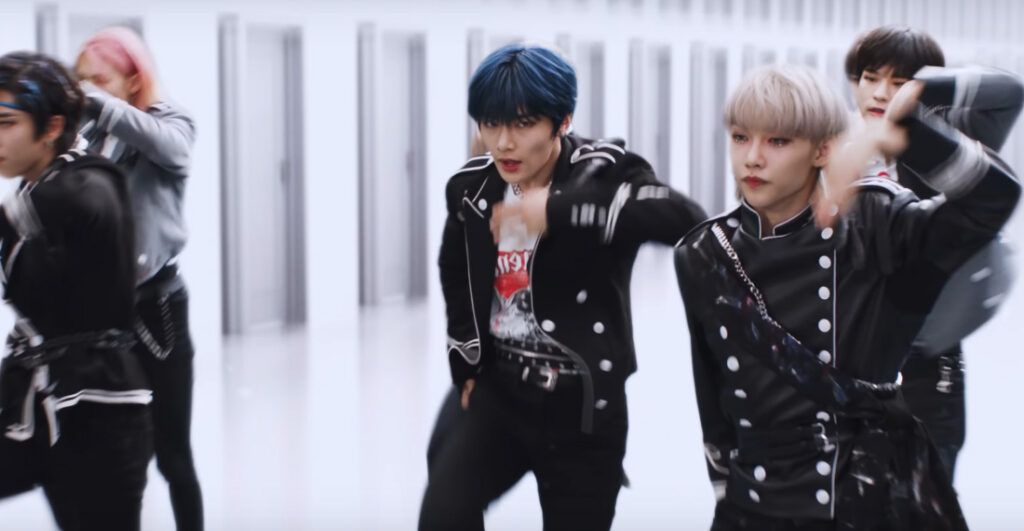
Said chorus is almost anticlimactic the first time you hear it (especially when compared to the usual full-blown EDM drop favoured by resident producer Bang Chan), using light plucks over sparse drums and bass to create a minimalist drop reminiscent of Red Velvet’s “Peek-a-Boo”. Instead of then just adding vocal ornamentations on top, however, they shift down to a new chord to keep things interesting, while repeating the same line three times: “Authorised personnel only, this is the back door”.
In terms of visuals, director Bang Jae-yeob complements this minimalistic style through the number of shots, sets and special effects used, matching every detail of the song perfectly while also calling back to “God’s Menu” (which he also directed). There are only three main sets – a closed art gallery, a dimly lit basement and a white, limbo-like world where hundreds of CGI doors line up.
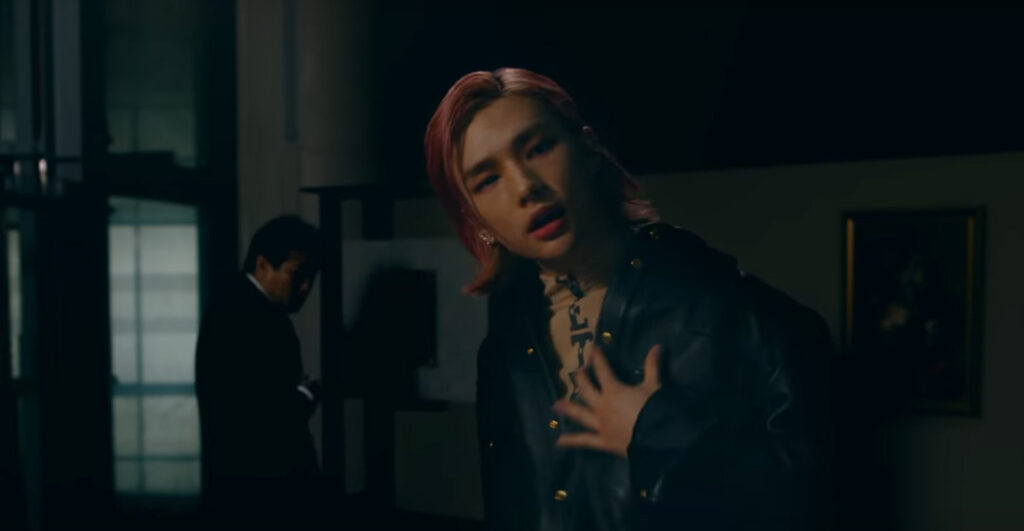
The basic narrative of the MV involves Stray Kids throwing a party in the gallery, bringing in more and more of their followers (people in white hoodies that represent their fans, Stays), while opposing forces (men in black suits) try to shut them down. The members defy them by pulling a lever to turn the lights on, which transports them to the white world full of doors – presumably, the “back doors” through which more and more Stays can come through, à la Monsters, Inc.. Meanwhile, the men in black continually shut off the lights, until they can control them no more and the climax scene shows hundreds of Stays filling up the gallery and dancing along, while a giant Stray Kids flag represents their conquest of the whole place and, implicitly, the music industry.
More than the story, it is the tasteful execution that makes this MV a pleasure to watch. Subtlety is its key aim; unlike MVs that opt for in-your-face visual impact from beginning to end, “Back Door” is all about the detail, the corner-of-your-eye glimpses and magician-like sleight of hand that keeps you focused on what’s in front of you, while giving you the feeling that all is not as it seems and strange things are happening right under your nose.
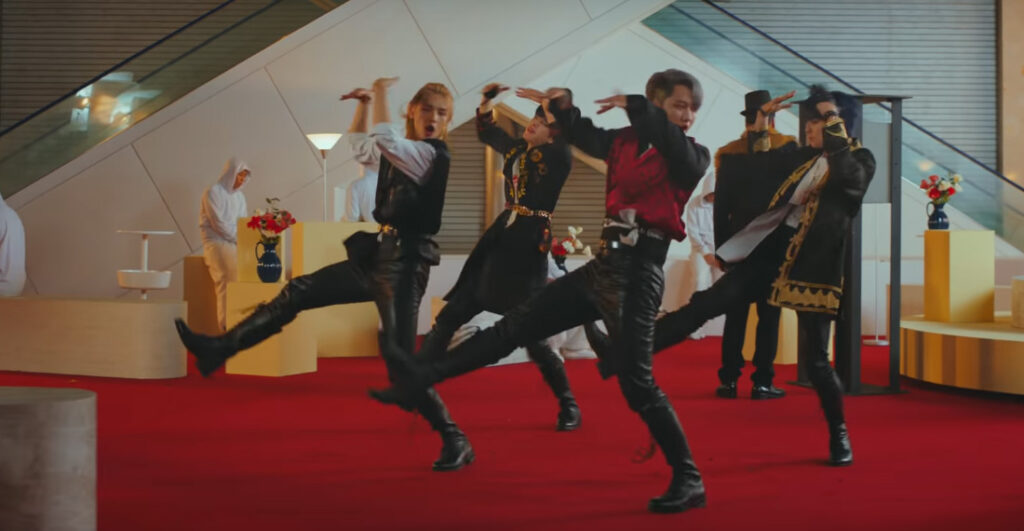
Visual and editing details that are impressive when you notice them are, perversely, designed to be almost invisible. For example, the people switching the lights on and off do so in the background or to the side, while you watch members dancing in the middle. On the verses, the same camera shot appears to repeat over and over, challenging you to spot the minute differences. During the chorus, they change outfits but remain in exactly the same set and dim lighting, so that it’s not immediately noticeable that they are now on their umpteenth outfit.
The most impressive sequence appears at the close of the song. After a group dance, they all run offscreen, before I.N and Han run back in from the sides to perform a pair dance. It seems perfectly doable, but the I.N and Han performing the group dance aren’t quite out of frame before the new I.N and Han appear – there are two of both onscreen simultaneously. The rest come in a few at a time, running and disappearing through a gate formed by Felix and Lee Know joining hands. Finally, Felix invites you one last time to join them, before disappearing himself through a ripple in the air, leaving a lonesome man in black who appears from nowhere wandering in the distance.
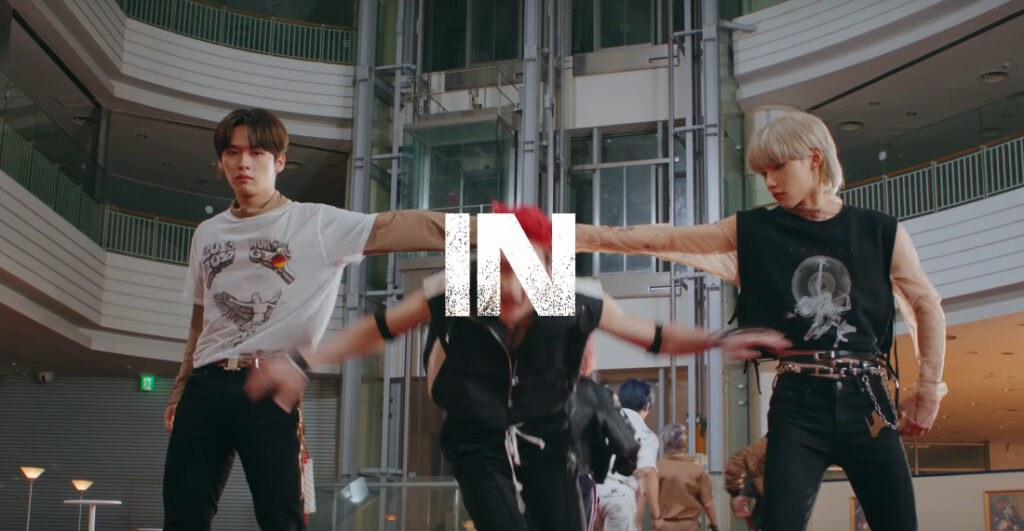
The way the members fold and disappear into one another until only Felix is left is an incredibly satisfying sequence of visual deception, created through skilful editing. The camera tilts up, so the less observant might assume that they have simply run out of frame; similarly, the screen is already fading to black with a logo on top as Felix walks into nothingness, so you might well miss it, wrongly assuming that the MV is over.
The whole video feels like a first-person view experience, with Stray Kids personally taking you on a journey through a private magic show, changing outfits and surroundings instantly with a casual flick of the wrist while you are disoriented by the constantly flickering lights. This is reinforced by the extremely smooth, realistic transitions, something “God’s Menu” also paid attention to. Unlike MVs which make sudden, random cuts to different shots, most of which don’t last more than a few seconds, “Back Door” makes use of extended shots, which are joined with either handheld whip pan transitions or soft crossfades that happen on beat with key moments in the song. Not only does this make every transition seem natural and seamless, it also reduces visual fatigue for the viewer and keeps you focused throughout, resulting in what feels like a very short runtime.
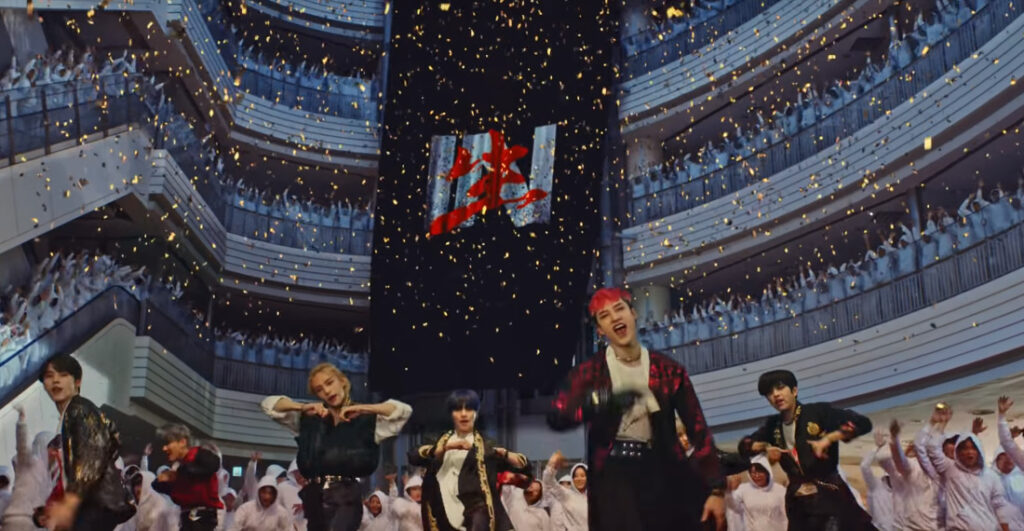
The best example of this is at the climax of the song, which is simply one long shot where the camera slowly zooms out, revealing a whole building full of Stays. As this is the climax, it would be normal to ramp up the camera shake and number of cuts in order to artificially increase the feeling of energy, but here they instead let the energy within the scene speak for itself – a quiet statement that, unlike others, they don’t need to fake anything.
Overall, “Back Door” shows us Stray Kids at their most refined yet. From the song to the MV, everything reveals a much more selective taste and thoughtful execution than we’ve seen so far; there’s a balance of chaos and order – of structure and free-flow – that many groups never achieve. Within their production, they’ve learned that sometimes less is more, and that instrumentals can be impactful without literally being a wall of sound. Within their songwriting, they’ve learned how to come up with fun original concepts, write catchy hooks that repeat just the right number of times, distribute parts economically to let every member shine, and structure a song so that it progresses with effortlessly natural flow.

They’ve replaced a slight tendency to melodramatise with a playfulness and self-assured ease that seems to have come as they spend more time in the industry. Three years after debut, they’ve finally sharpened the knife until it’s capable of cutting only what is needed, and is therefore worthy of the “God’s Menu” they hope to create; if the appetiser and starter are anything to go by, then by all means, the main course is worth looking forward to.
(YouTube [1]. Lyrics via Pop!Gasa. Images via JYP Entertainment.)
